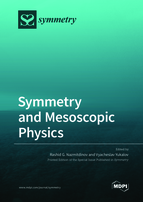Symmetry and Mesoscopic Physics
A special issue of Symmetry (ISSN 2073-8994). This special issue belongs to the section "Physics".
Deadline for manuscript submissions: closed (15 February 2021) | Viewed by 37476
Special Issue Editors
Interests: optimized perturbation theory; self-similar approximation theory; method of self-similar prediction; correlated iteration theory; theory of heterophase fluctuations
Special Issues, Collections and Topics in MDPI journals
Interests: transport in nanostructures; graphene; random matrix approach; nuclear structure
Special Issues, Collections and Topics in MDPI journals
Special Issue Information
Dear Colleagues,
Symmetry is one of the most important notions in natural science. This notion lies at the heart of fundamental laws of nature and serves as an important tool for understanding the properties of complex systems, both classical and quantum.
The other trend, which has in recent years undergone intensive development, is mesoscopic physics. This branch of physics also combines classical and quantum ideas and methods. Two main directions can be distinguished in mesoscopic physics. One is the study of finite quantum systems of mesoscopic sizes. Such systems, which are between the atomic and macroscopic scales, exhibit a variety of novel phenomena and find numerous applications in creating modern electronic and spintronic devices. At the same time, the behavior of large systems can be influenced by mesoscopic effects, which provides another direction within the framework of mesoscopic physics.
The aim of the present Special Issue is to emphasize the phenomena that lie at the crossroads between the concept of symmetry and mesoscopic physics. For example, the role of symmetry becomes apparent in the interplay between order and chaos in the classical limit, suggesting the most probable realizations of quantum equilibrium configurations of finite systems. On the other hand, the manifestation of symmetries and symmetry breaking in finite quantum systems has some peculiarities compared to macroscopic samples.
We are soliciting contributions (research and review articles) covering a broad range of topics on symmetry and mesoscopic physics, including (though not limited to) the following:
interplay between regular and chaotic dynamics in finite systems
particles confined in effective potentials of different shapes
manifestation of symmetry in the spectra of collective excitations
mesoscopic effects in large systems
local symmetry breaking
competition between order, disorder, and symmetry
possible coexistence of different types of symmetry breaking
symmetries in nanoscience
applied problems focusing on the role of symmetry in nano- and mesoscopic devices
Guest Editor
Dr. Vyacheslav Yukalov
Dr. Rashid G. Nazmitdinov
Guest Editors
Manuscript Submission Information
Manuscripts should be submitted online at www.mdpi.com by registering and logging in to this website. Once you are registered, click here to go to the submission form. Manuscripts can be submitted until the deadline. All submissions that pass pre-check are peer-reviewed. Accepted papers will be published continuously in the journal (as soon as accepted) and will be listed together on the special issue website. Research articles, review articles as well as short communications are invited. For planned papers, a title and short abstract (about 100 words) can be sent to the Editorial Office for announcement on this website.
Submitted manuscripts should not have been published previously, nor be under consideration for publication elsewhere (except conference proceedings papers). All manuscripts are thoroughly refereed through a single-blind peer-review process. A guide for authors and other relevant information for submission of manuscripts is available on the Instructions for Authors page. Symmetry is an international peer-reviewed open access monthly journal published by MDPI.
Please visit the Instructions for Authors page before submitting a manuscript. The Article Processing Charge (APC) for publication in this open access journal is 2400 CHF (Swiss Francs). Submitted papers should be well formatted and use good English. Authors may use MDPI's English editing service prior to publication or during author revisions.
Keywords
- interplay between regular and chaotic dynamics in finite systems
- particles confined in effective potentials of different shapes
- manifestation of symmetry in the spectra of collective excitations
- mesoscopic effects in large systems
- local symmetry breaking
- competition between order, disorder, and symmetry possible coexistence of different types of symmetry breaking
- symmetries in nanoscience
- applied problems focusing on the role of symmetry in nano- and mesoscopic devices
Benefits of Publishing in a Special Issue
- Ease of navigation: Grouping papers by topic helps scholars navigate broad scope journals more efficiently.
- Greater discoverability: Special Issues support the reach and impact of scientific research. Articles in Special Issues are more discoverable and cited more frequently.
- Expansion of research network: Special Issues facilitate connections among authors, fostering scientific collaborations.
- External promotion: Articles in Special Issues are often promoted through the journal's social media, increasing their visibility.
- e-Book format: Special Issues with more than 10 articles can be published as dedicated e-books, ensuring wide and rapid dissemination.
Further information on MDPI's Special Issue polices can be found here.







